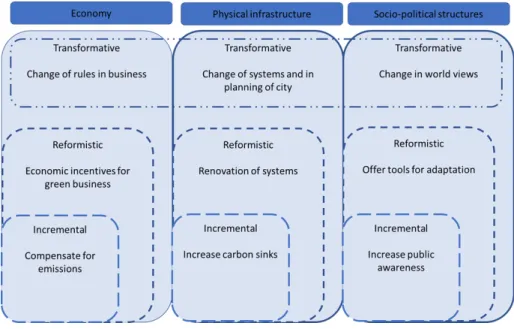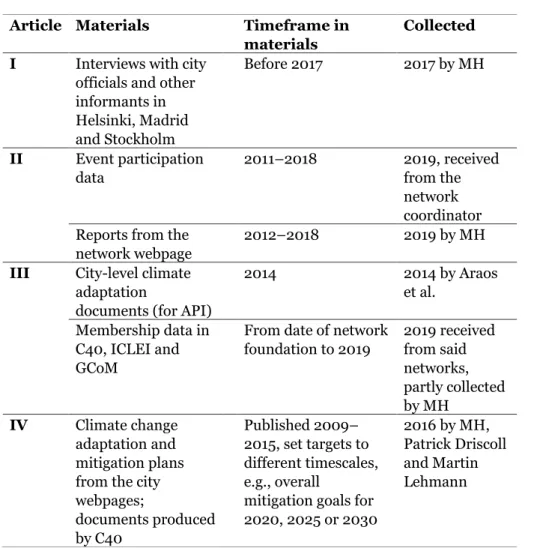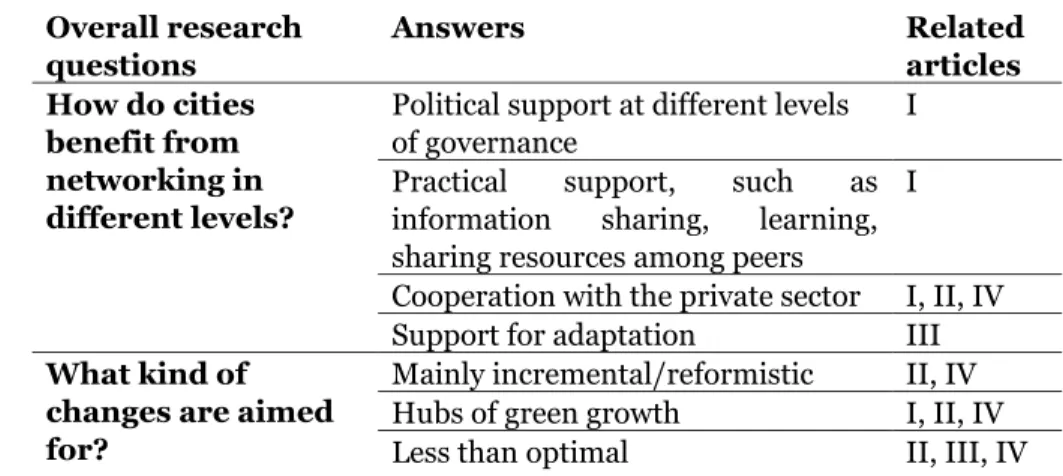For the data used in Article III, I thank Malcolm Araos and his colleagues at the Tracking Research on Adaptation to Climate Change Consortium (TRAC3), who kindly shared their data with our group. Climate change is found to be strongly associated with biodiversity loss, another major crisis threatening environmental sustainability (e.g. Dinerstein et al. 2020).
Focus and aim of the thesis
Furthermore, it should be noted that in the networks often referred to as city networks, such as the global C40 network, not all the relevant actors are cities. In the next section, I cover the state of the art in the urban climate policy and management literature, concentrating on formal urban networking.
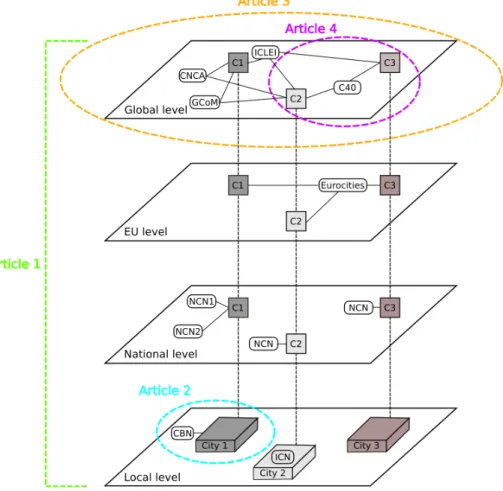
Urban climate policy and governance
Global climate governance is a good example of the complexity of the current multi-actor, multi-level nature of global environmental governance (Betsill & Bulkeley 2006, Andonova et al. 2009). In addition, the consumption of goods and services in cities causes emissions outside the city limits (Rosenzweig et al. 2011).
Formal networking in the urban context
There are different ways of defining when a city is carbon neutral, and some clarity is needed both for the definition of the concept and the role of compensation in it (Huovila et al. 2022). Recent studies have also shown a statistical relationship between network participation and declining emissions for the nationwide network HINKU (Karhinen et al. 2021) and TMNs (Leffel 2021).
Sustainability science and realism
I do not assume that these causal relationships are directly observable or that they are immutable.
Analytical framework categories
I defined the degree of change as a three-step scale based on the climate adaptation literature (Basset & Fogelman 2013, Pelling et al. 2015). The first step, adjustment (Basset & Fogelman 2013) or resistance (Pelling et al. 2015), involves taking the smallest action to maintain the status quo. Reformist adaptation (Basset & Fogelman 2013) or incremental adaptations (Pelling et al. 2015) occupy the middle ground.
Formalized networks (Acuto & Rayner 2016, Gordon & Johnson 2017, Davidson et al. 2019a), but members may be different from cities; benefits of networking (see Table 1); various levels of networking (city organization, local, national, EU, global). ICLEI, C40, GCoM Progress in adaptation planning processes quantified as API, defined by Araos et al. Formalized networks (Acuto & Rayner 2016, Gordon & Johnson 2017, Davidson et al. 2019a), focusing on C40; degree of change (incremental, reformist and . transformational) (Basset .. infrastructure, economy and socio-political structures).
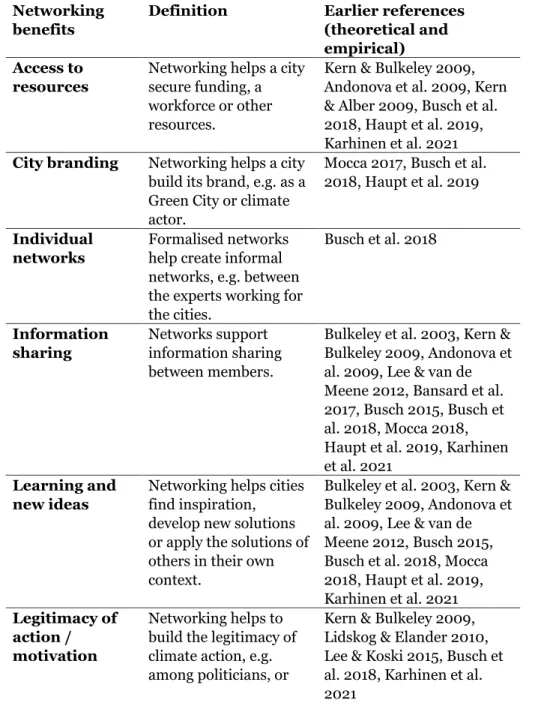
Materials
However, Madrid is a member of C40, among other networks, which had its European office in the city at the time of the study. I did not include all supplementary words and voices in the transcriptions because they were not relevant to the analysis. First, we divided the participants of the events according to their membership status into business members (BM), other members (OM) and non-members (NM).
This is a voluntary activity, but discussions with the CP coordinator indicate that it was found to be an important way to participate in the network. Documents in the following languages were included: English, Spanish, French, Chinese, Arabic, Russian, German, Portuguese, Farsi, Korean, Japanese, Turkish, and Indonesian (Araos et al. 2016). Additionally, I estimated that sites that are frequently mentioned in C40 documents are likely to be more active in the network than those that are rarely mentioned.
Analysis
- Qualitative content analysis
- Graph analysis
- Indicator analysis
- Statistical analysis
Reference to the responsibility to participate in the global goal of climate change mitigation / sustainable development. In our case, by analyzing the graphs, we detected, for example, groups of CP members who participate in the largest number of events together, which would be difficult if the task was performed manually. In the literature, bipartite graphs have been used to study various phenomena such as participation in various activities (Piccolo et al. 2018) and the relationship between aid organizations, development issues, and aid recipient countries (Coscia et al. 2018). others 2013).
The three parts, namely goal setting, reporting and impact, are based on the three possible direct impacts found in the literature (van der Heijden 2020, de Vries et al. 2012). However, in our case, the API distribution over the sample was overdispersed and contained zero excess amounts, meaning that many of the cities in the sample were not involved at all in the type of adaptation planning we studied. Therefore, we used zero-inflated negative binomial models, which can account for the large number of zeros in the data.
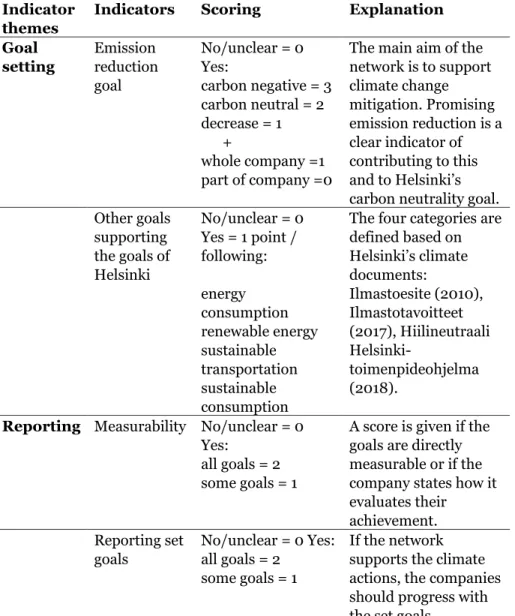
Benefits of multilevel networking
I start with the overall benefits of multi-level networks from the urban perspective (Article I) and then move on to special cases of CBNs (Article II) and the potential support global networks can provide to the climate adaptation process (Article III). In this study, the highlights were the opportunity to participate in EU-funded projects and influence EU legislation – and thus national legislation – through networking. At the national level, networks help cities to influence national legislation from below and promote cooperation at the national level, such as pooling resources.
Another important advantage was the possibility of pooling resources, such as financing a specific project. The city uses international networks to gain political support and influence climate policies at EU level. Local networks enable cooperation with various actors that influence the amount of GHG emissions in the city region.
City-to-business networks
When it comes to analyzing participation in reporting, the index's scores show that while a few members of the CP are ambitious, most report low or mediocre results. Therefore, ambition or lack of it is not linked to special characteristics of the business areas. Some of the companies have some form of climate change mitigation or adaptation included in their business ideas (e.g. they offer a service that can help their customers save energy) and the promise they make to CP is to continue business as usual .
Each year, less than half of the reporting members set a direct target for emissions reduction. In reporting emission reductions, even in the best year (2014), fewer than half of the companies reported any reductions. Values of the performance index are calculated over the entire period as a function of degree normalized by the total number of events in each company's members.
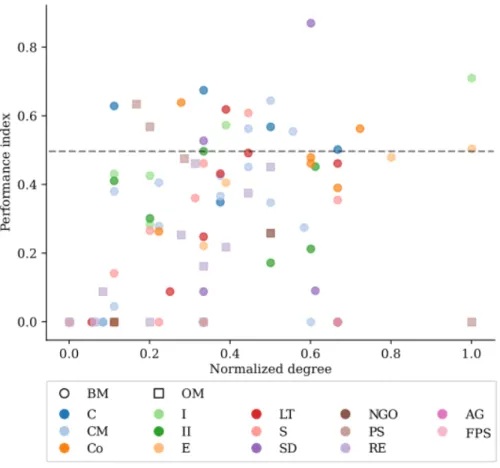
Global networking and climate adaptation
Degree of change
However, more reformist solutions were also planned, such as changing the city's energy planning guidelines to increase the energy efficiency of new buildings throughout their life cycle. Solutions with transformative characteristics aimed to change the basis of the systems and their planning in the city. This aspect was more often present in the plans of cities from the Global South than in the Global North.
The city also believed that action should be taken beyond the borders of neighboring municipalities, otherwise it would face an immigration problem. Some cities in the Global South highlighted the role of reducing inequality on an international level by citing the importance of international climate finance. In the following paragraphs I further elaborate on the answers my results give to the research questions (6.1), the limitations of the thesis (6.2) and future directions (6.3.).
Networks are beneficial but not transformational
Because of this diversity, the polycentric system of all climate-focused city networks can be comprehensive even if none of the networks is able to offer similar opportunities to all cities in different contexts (Cortes et al. 2022 ). The development of better and more comparable emission calculation methods can also be a benefit of networks (Huovila et al. 2021). Focusing primarily on fairly similar technological solutions (IV) is also problematic because it does not support multiple pathways, which are likely needed for sustainability transformation (Scoones et al. 2020, Bulkeley et al. 2022).
The institutionalization of sustainability in the form of sustainable development also supports the idea of the win-win solution of green growth (Purvis et al. 2019). The situation may change as the understanding of planetary boundaries deepens (Rockström et al. 2009, Steffen et al. 2015). For example, a recent survey found that the environmental protection specialists of the German Environmental Agency were overwhelmingly critical of the concept of green growth, favoring a- or post-growth, and those with the most knowledge of the subject are usually the most critical (Lehmann et al. 2022).
Limitations
Their value should be evaluated as part of the literature on the subject. In Article III, this meant a global dataset for which documents were analyzed in 13 different languages, including all official languages of the UN (Araos et al. 2016). For Article IV, I collected documents from 12 cities, half of which were from non-Annex I UNFCCC countries (Buenos Aires, Delhi, Ho Chi Minh City, Johannesburg, Lagos, São Paulo).
Nevertheless, this does not necessarily mean that the overall conclusions of the study are outdated. The cities may have changed their ideas of the scale of change needed as calls for sustainability transformation grew stronger, as explained in the introduction. At the same time, some of the analyzed planning documents and goals had target years that are still in the future.
Open questions: power, individuals and meaning of
2019b) and Acuto and Ghojeh (2019) have previously pointed to the need for a better understanding of the role of individuals in the context of TMNs such as C40. Third, with regard to the above discussion of the nature and location of power, we need to recognize and understand the role of individuals from the point of view of how power is distributed in formalized networks. New research on climate change and other aspects of sustainability may influence what is seen as important or realistic in these networks and other projects.
Looking Back and Thinking Ahead: A Decade of Research on Cities and Climate Change, Local Environment Vol. Comparing apples and oranges: the problem of dependent variables in comparing and evaluating climate change adaptation policies. Contribution of Working Group II to the Sixth Assessment Report of the Intergovernmental Panel on Climate Change [H.-O.
Contribution of Working Group III to the Sixth Assessment Report of the Intergovernmental Panel on Climate Change. Contribution of Working Group II to the Fifth Assessment Report of the Intergovernmental Panel on Climate Change [Field, C.B., V.R. Cambridge University Press, Cambridge, United Kingdom and New York, NY, USA, pp.
